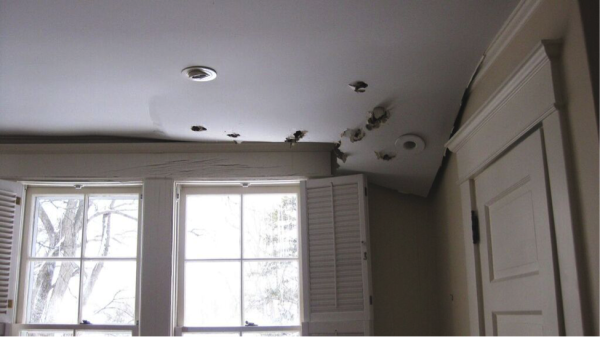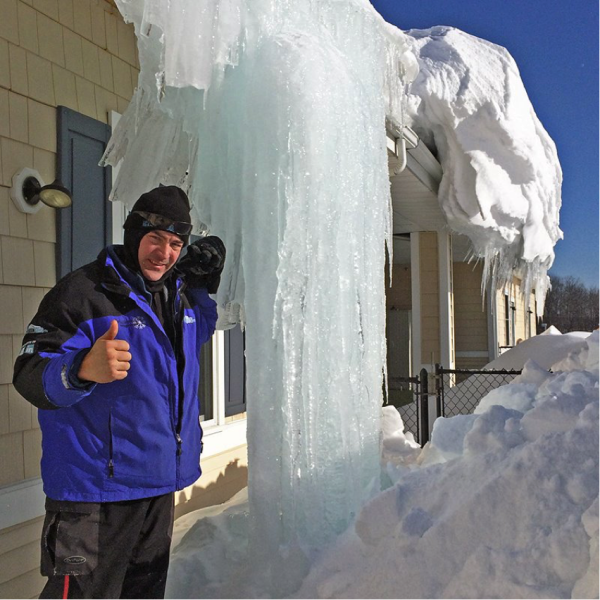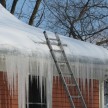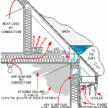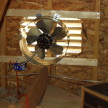Ice Dams
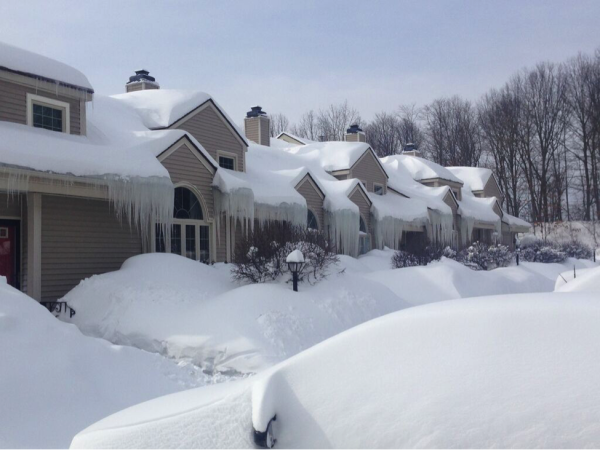 Is Your Home Ice-Dam-Resistant?
Is Your Home Ice-Dam-Resistant?
Most people don’t think much about ice dams when they’re purchasing a new home, especially not if they’re first-time homebuyers. That’s understandable. Between your excitement of getting a new castle and the long list of other things you have to worry about, it’s easy to overlook whether your dream home is or isn’t prone to ice dams.
But as you may know, ice dams can be dangerous and expensive to deal with. To avoid the financial burden of ice dams, you’ll need to do at least one of two things:
- include some ice dam removal money in your home-maintenance budget, or
- buy a home that’s less likely to get ice dams in the first place.
About a third of the homes we get called to are “leakers:” the ice dams have caused leaks into the interior of the home, sometimes causing structural damage. By that point, the ice dam has gone from a four-figure problem to fix to possibly a five-figure disaster.
Finding a home that won’t leave you grappling with ice dam emergencies winter after winter is half luck, and half knowing what to look for.
The pitch of the roof matters.
Try to find out the pitch of the roof. Steeper roofs are less likely to have trouble with ice dams. On the other hand, those shallow, 4/12 pitch roofs could put an ice dam removal technician’s kid through college.
A steep roof holds less snow and sheds water quickly. As the snow melts, the water races down your roof and onto the ground. On a shallow roof the water just slowly oozes down the slope of the roof (as if in slow-motion) until it refreezes near the overhangs.
You may also want to avoid a house that has many dormers or valleys (areas where two pitched roofs intersect). Ice dams love to put down roots in any “V” shapes on your roof.
What if the home of your dreams has a shallow roof or a half-dozen roof valleys? Well, just know that your manor may need ice dam removal in the winter months.
Insulation and ventilation are the keys to an ice- dam-free home
A hot attic means warm shingles, which cause snow to melt, run down your roof, refreeze along overhangs and in valleys, and cause the dreaded ice dam(s). Anything you can do to minimize heat in your attic will minimize your risk of getting ice dams.
Your first step should be to get an energy audit, preferably right after you buy the home. If possible, also ask the seller whether he or she has had an energy audit done recently. If the answer is yes, ask them to provide you with a copy and have a look at it. This would also be a good time to ask the previous owners if they’ve had any ice-dam issues in the past.
Your goal is to find out where the thermal leaks are. An energy audit is a smart move in general, because it will help you maximize comfort and minimize energy bills. As far as ice dam prevention is concerned, you want the energy audit because it will tell you where hot air is leaking into your attic and how well your attic can dissipate that heat.
Your home-energy auditor will most likely tell you to fix the insulation and ventilation in your attic. I suggest taking his or her recommendations, and then hiring an insulation contractor to make it happen.
Proper insulation will reduce the amount of heat that leaks through the ceiling of your top floor and into your attic. Hot air can also enter the attic through what are known as “attic bypasses” – meaning pretty much anything that penetrates the walls or ceilings. Examples of common attic bypasses include attic doors, electrical outlets, light switches, light fixtures, vents, and smoke detectors. These areas can allow warm air to leak from the living space directly into the attic. Covering them or packing the area around them with fresh, thick fiberglass insulation is usually the best way to reduce the amount of hot air that escapes (and it can reduce your energy bills).
Of course, some heat will always find its way into the attic, which is why you may also need to improve the ventilation in your attic. That’s usually a matter of unclogging or replacing your roof vents or soffit vents, or adding a ridge vent, or some combination thereof. Your insulation contractor should also be able to advise you on the best way to improve the ventilation in your attic, if needed.
None of this is a guarantee.
The little lawyer on my shoulder me to say that. But he brought up a good point (for once).
You may do everything in your power to prevent ice dams and still get them. You’re prone to ice dams any time the snow on your roof can melt into water. The warmth of your attic often causes that melting, but so can the weather. That’s why an ice dam can form during a stretch of warm days with below-freezing nights.
You might have ice-dam-proofed your home enough to avoid ice dams during “normal” winters, but even an attic that’s just slightly too warm might be enough to cause ice dams after a big snowstorm. A thick layer of snow traps even more heat in your attic, especially if the snow plugs your roof vents. You’ll want to rake the snow off your roof frequently, even if you’ve got proper insulation and ventilation. Buy a roof rake and use it to pull as much snow off your roof as possible. If there’s no snow on your roof, nothing can melt and then refreeze into an ice dam. I recommend raking your roof after every 6 inches of snowfall, if possible.
You may also want to sock away some money for ice dam removal, just in case. Even a small ice-dam fund can help you get the ice off your roof before it causes a major leak. That’s the best way to avoid needing to call repairmen with sledge hammers and Sawzalls in the spring.
About the Author
Joe Palumbo is president of Ice Dam Guys, based in Minnesota’s Twin Cities. In the record-breaking winter of 2014-2015 he sent his entire crew to greater Boston to remove ice dams and help homeowners.




